
© Copyright Goldendoodles.com 2001. All rights reserved. You may not copy or otherwise use anything on this site without our written permission.
Made with Xara
.


Goldendoodles.com
Responsible Dog Ownership
Page 1 - Page 2
BEFORE YOUR PUP COMES HOME
• Training Techniques • Puppy Proofing your house • Decisions on Food • New Puppy (Shopping) Checklist • Veterinary CareAFTER YOUR PUP COMES HOME
• Health Risks of Parvo • Sleeping Crates • Trained to the Bell • Teething & Chewing • Proper Exercise for your pup • Puppy Etiquette • Microchipping • If you have a pool • If there is a problem with your dogIF YOU HAVE YOUNG KIDS
• Advice from parents of young kids • Great website teaching kids to handle dogs BEFORE YOUR PUP COMES HOME • Training Techniques If you have just found the Dood of your dreams, odds are you are on a waiting list and have time to read up. It is important for young pups/dogs to socialize, to begin to deal with distractions, to interact with strangers and to be trained. There are some smart shortcuts to training and living with dogs that are available in books and videos. Each hour you spend in preparation, will save you ten in training. Check out the different methods used, to find the one that your pup best responds to. Current Popular Favourites: The Dog Listener by Jan Fennell How to Raise a Puppy You Can Live With by Clarise Rutherford and David Neil Childproofing Your Dog : A Complete Guide to Preparing Your Dog for the Children in Your Life by Sarah Wilson and Brian Kilcommons BACK TO TOP • Puppy Proofing your house As with children, you will likely want to puppy proof your house. Part of it is to keep the pup safe, and the rest is to keep your stuff safe from the pup. Puppies chew things. Everything below four feet is fair game. Expect it and prepare for it. One of the best solutions is to offer a wide variety of puppy safe chew products all over each accessible floor in the house. If the pup is going to chew, you might as well control what he is chewing. Use child proof locks to keep substances like pesticides, meds, cleaning products, plants, etc locked up in cabinets and away from your pup. When pups are very young, even rawhide strips can be dangerous, and they should be using the rawhide sticks (made up of bits of rawhide pressed together). Be aware that some foods and plants are toxic to dogs. Avoid heat stroke and don't leave pups or dogs locked in cars. Dog Tags and House Vents - A Cautionary Tale Ms. Sadie the Goldendoodle loves the coolness of the air conditioning vent. To the horror of the owner, she was found with the tags from her collar stuck in the vent, and she was so tight against the floor that she couldn't stand up. She had twisted herself to the point where she was almost choking. Ms. Sadie will not wear a collar inside the home again. Her collar has been attached it to her leash so when she is let out to potty, the collar & leash are clipped on at the same time. BACK TO TOP • Decisions on Food As with most things, there are a wide variety of choices in dog food. Most major products are online and search engines can bring up sites that compare the different dog foods to one another. Many opt for Bones And Raw Food or the BARF diet, which also has many websites discussing issues and offering recipes. Breeders will often give a new puppy owner a small supply of the food they have been eating. If you plan to change foods, it is easiest on the pup to make it a gradual change. BACK TO TOP • New Puppy (Shopping) Checklist Having trouble trying to figure out what to pick up before the new arrival? Here is a terrific checklist to help you prepare for the new puppy - New Puppy Checklist • Veterinary Care Proper Veterinary care is a commitment to your dog's long-term health. Choose a Vet you are comfortable with and be sure that your dog gets the lifetime of care he deserves. Be prepared for emergencies and know where your local emergency Vet clinic is. Purchase a dog health care book like the Dog Owner's Home Veterinary Handbook to keep on hand. Take it upon yourself to learn about the drugs prescribed to your dog. Don't leave anything to chance. Merely "google" the name of the drug your pet is being prescribed. Be well informed of potential serious or fatal side affects in case your pet exhibits any of those signs. -from a dog owner who learned the hard way BACK TO TOP AFTER YOUR PUP COMES HOME • Health Risks of Parvo Your breeder will likely tell you that you should NOT be allowing your pup out in public places until after the Parvo vaccinations have been completed. Parvo is a deadly silent killer, so please take heed of this warning. Some areas have more incidence of Parvo than others, so follow the advice of your Vet and don't allow your pup outside until they feel that the pups' immune system can handle it. Once your pup is fully immunized, then they are ready to go out and meet the world. BACK TO TOP • Sleeping Crates Many families find the use of a crate makes housetraining easier, and that the pups use their crate as a quiet spot to nap. Remember that when pups first come home they are 'babies' and have very small bladders. For the first few weeks they should be allowed to relieve themselves every few hours at most. Then, as they grow, they will be able to hold it in comfortably for longer periods. BACK TO TOP • Trained to the Bell The object of training a pup to a bell is for them to communicate when they need to go outside. First they have to connect going outside with ringing the bell. Hang a large puppy-proof bell from a sturdy ribbon by the door, where you let out your pups. Everytime you take them out, say 'outside' and jingle the bell. At first you will take them out often. For the first week or two they should be let out: • when they wake up • after they eat • after they drink • if they start to sniff and circle • every 20 minutes or so while they are awake Thankfully puppies sleep a lot. But the trick is to let them understand that outside is for relieving themselves. It's a new concept for them - but if it's clear, then they will understand what they need to do. The less accidents they have, the faster they learn. It takes some dogs only a few days to learn to ring the bell to ask to go out. (And for a while there, you're trained to the bell, because they go often - but it's worth it in the long run.) • Teething & Chewing Puppies go through a teething stage where they will need to chew. We can control what they chew. Like kids, pups learn faster if you show them what they can do, as opposed to what they can't. Litter the house with rawhide chewsticks (the cylinder shaped ones that are made up of bits so pups can't choke) and soft toys. Each time you cuddle a pup, hold a soft toy near their mouth, because they naturally want to chew. They will chew the toy, not your hands. If you see them about to chew the leg of a chair, say in a deep voice, 'NO', pull them away and then hand them a rawhide, or some toy they can chew. (Then it's a good idea to spray the chair leg with a sour apple spray). These pups are clever, they learn fast. BACK TO TOP • Proper Exercise for your pup The best advice in keeping a pup well behaved and healthy, is to give him plenty of exercise. Puppies especially have LOTS of energy, and if they don't expend it through safe exercise -- then they are more likely to misbehave and be destructive at home. Make a schedule for several daily walks, including one good run each day. If you work all day - look into a local dog walker helping you out. Your dog will appreciate it. You will appreciate a more relaxed dog. BACK TO TOP • Puppy Etiquette Be a responsible dog owner and train your pup to be respectful of others. Train them not to bark, please pick up their waste and respect others' rights to NOT love your unruly dog and not want to be jumped on. Most urban areas have leash laws, poop'n scoop laws and noise laws which help to make common areas enjoyable to all BACK TO TOP • Microchipping Consider microchipping your Dood. It will help provide identification should your dog ever get loose. There are at least two companies that provide microchips, you might want to consider what shelters in your area use for convenience sake. BACK TO TOP • If you have a pool If you have a pool teach your dog to stay out or learn where the steps are. A dog will naturally swim to the point it fell in and will drown working to get out just feet from the steps. Take it in and out via the steps for the first few times in the pool. Next gently place the dog in the pool at another place other than the steps and guide it to the steps. Do not leave a dog alone anywhere near the pool until it can be placed in the pool at any location and naturally swim to the steps to get out. BACK TO TOP • If there is a problem with your dog The first thing any new dog owner should do is to take their pup to a Vet for a routine first checkup. Most breeder warranties stipulate that a pup must be seen by a Vet within a short time period - usually up to 72 hours. This protects the breeder, pup and owner by guaranteeing that the pup is checked by a Vet who will verify the health of the pup and continue the innoculations initiated by the breeder within a reasonable timeframe. Some States have mandatory laws which protect puppy buyers. Here is one good list on the net that has a list of Puppy Lemon Law States. Check to see if there are laws in place that deal specifically with your situation. If a problem occurs at any point in the dog's life, the responsible thing to do is to first notify the breeder about the problem. Even a breeder with a warranty that doesn't cover the problem would be well served by getting feedback about unhealthy offspring. Otherwise valuable feedback is lost to the breeder, and the same breeding dogs can be used again. If the breeder doesn't know there is a problem, they can't fix it. BACK TO TOPIF YOU HAVE YOUNG KIDS
• Advice from parents of young kids If they have children, they need to consider: How will they handle normal puppy behaviors like nipping, stealing toys, chewing, and jumping? How will they teach their children to be good and kind leaders? Who will be responsible for teaching the children these things? Even if the dog is for the kids, the parents will be doing the lion's share of the work and should be prepared for it. Pups are not disposable pets. I think the age of the kids and the size of the Dood should be a big consideration. Whenever I see rehomes it is usually a standard sized dood and a family with young toddler that simply can't handle a big teenaged dog and very young children all at once. I also think EVERYONE in the family needs to agree on the dog, it only one person wants it it doesn't work and its not fair to the dog. Your life/routine will change after you bring home your puppy. It's important to consider the puppy stage. I was pretty ignorant about the puppy biting and all the typical puppy behaviors. Be prepared for this stage, but also be aware that it's temporary and in the long run they are behaviors the pup grows out of. The amount of work & frustration of first year is equal to having an infant. Beware mixing pups and small kids if you are a dog beginner. Your allegiances will get sorely tested. We have four kids, so there were 'rules of play'. To play with the pup you need to get down to their level. Never let them get up on two legs. It's cute at 2 months, it can knock you over at 7. If you always kneel or sit, they never learn to jump up. No running in the house, all active play outdoors. Never let the dogs chase, or play tug of war with you - it will lead to pulling on clothes. When the doorbell rings, wait a second or two then calmly walk to the door. If you don't make a big deal of it, they won't learn to run to the door barking. The majority of rehomes I've seen are due to the doods being "too much dog" for toddlers (and even older kids). There's a common myth out there that puppies and small children go together. I've learned that's not necessarily true. Never leave pups and young kids unsupervised. Don't expect a little cuddly, soft, lap pet at the beginning---when they are not sleeping, they are wired, biting, running little dervishes. Appearances can be deceiving in the case of a sweet, soft, tiny little puppy. But have PATIENCE -- they DO grow out of the craziness! A big issue with us is that our child's only experience with a dog was a mature dog who would tolerate anything or would walk away when he was bothered. Now he has a puppy who will bite at him, sometime unprovoked just to get him to play! BACK TO TOP • Great website teaching kids to handle dogs The Safe And Sound Safety Factor Challenge is a fun online site for children which teaches them how to safely handle a dog in certain situations. click here to visit the site! BACK TO TOP






Some pups come with their ‘homes’...
others make themselves to home.



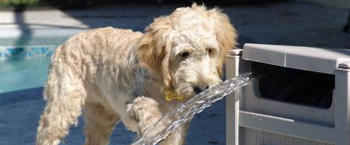
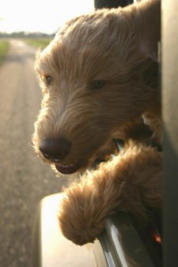



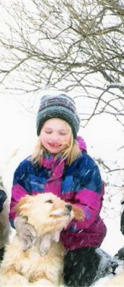
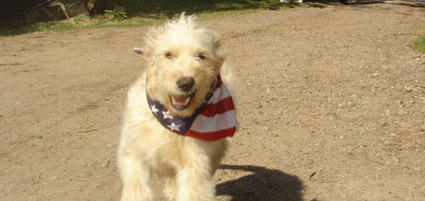
The information contained on this site is in no way intended to replace that of proper veterinary advice, diagnosis or treatment.
It is meant to provide resource, so that we can better understand canine health related issues.

© Copyright Goldendoodles.com 2001. All rights reserved. You may not
copy or otherwise use anything on this site without our written permission
Made with Xara
.
Responsible Dog Ownership - Page 2
BEFORE YOUR PUP COMES HOME
• Training Techniques • Puppy Proofing your house • Decisions on Food • New Puppy (Shopping) Checklist • Veterinary CareAFTER YOUR PUP COMES HOME
• Health Risks of Parvo • Sleeping Crates • Trained to the Bell • Teething & Chewing • Proper Exercise for your pup • Puppy Etiquette • Microchipping • If you have a pool • If there is a problem with your dogIF YOU HAVE YOUNG KIDS
• Advice from parents of young kids • Great website teaching kids to handle dogs BEFORE YOUR PUP COMES HOME BACK TO TOP • Training Techniques If you have just found the Dood of your dreams, odds are you are on a waiting list and have time to read up. It is important for young pups/dogs to socialize, to begin to deal with distractions, to interact with strangers and to be trained. There are some smart shortcuts to training and living with dogs that are available in books and videos. Each hour you spend in preparation, will save you ten in training. Check out the different methods used, to find the one that your pup best responds to. Current Popular Favourites: The Dog Listener by Jan Fennell How to Raise a Puppy You Can Live With by Clarise Rutherford and David Neil Childproofing Your Dog : A Complete Guide to Preparing Your Dog for the Children in Your Life by Sarah Wilson and Brian Kilcommons BACK TO TOP • Puppy Proofing your house As with children, you will likely want to puppy proof your house. Part of it is to keep the pup safe, and the rest is to keep your stuff safe from the pup. Puppies chew things. Everything below four feet is fair game. Expect it and prepare for it. One of the best solutions is to offer a wide variety of puppy safe chew products all over each accessible floor in the house. If the pup is going to chew, you might as well control what he is chewing. Use child proof locks to keep substances like pesticides, meds, cleaning products, plants, etc locked up in cabinets and away from your pup. When pups are very young, even rawhide strips can be dangerous, and they should be using the rawhide sticks (made up of bits of rawhide pressed together). Be aware that some foods and plants are toxic to dogs. Avoid heat stroke and don't leave pups or dogs locked in cars. Dog Tags and House Vents - A Cautionary Tale Ms. Sadie the Goldendoodle loves the coolness of the air conditioning vent. To the horror of the owner, she was found with the tags from her collar stuck in the vent, and she was so tight against the floor that she couldn't stand up. She had twisted herself to the point where she was almost choking. Ms. Sadie will not wear a collar inside the home again. Her collar has been attached it to her leash so when she is let out to potty, the collar & leash are clipped on at the same time. BACK TO TOP • Decisions on Food As with most things, there are a wide variety of choices in dog food. Most major products are online and search engines can bring up sites that compare the different dog foods to one another. Many opt for Bones And Raw Food or the BARF diet, which also has many websites discussing issues and offering recipes. Breeders will often give a new puppy owner a small supply of the food they have been eating. If you plan to change foods, it is easiest on the pup to make it a gradual change. BACK TO TOP • New Puppy (Shopping) Checklist Having trouble trying to figure out what to pick up before the new arrival? Here is a terrific checklist to help you prepare for the new puppy - New Puppy Checklist • Veterinary Care Proper Veterinary care is a commitment to your dog's long-term health. Choose a Vet you are comfortable with and be sure that your dog gets the lifetime of care he deserves. Be prepared for emergencies and know where your local emergency Vet clinic is. Purchase a dog health care book like the Dog Owner's Home Veterinary Handbook to keep on hand. Take it upon yourself to learn about the drugs prescribed to your dog. Don't leave anything to chance. Merely "google" the name of the drug your pet is being prescribed. Be well informed of potential serious or fatal side affects in case your pet exhibits any of those signs. -from a dog owner who learned the hard way BACK TO TOPAFTER YOUR PUP COMES HOME
• Health Risks of Parvo Your breeder will likely tell you that you should NOT be allowing your pup out in public places until after the Parvo vaccinations have been completed. Parvo is a deadly silent killer, so please take heed of this warning. Some areas have more incidence of Parvo than others, so follow the advice of your Vet and don't allow your pup outside until they feel that the pups' immune system can handle it. Once your pup is fully immunized, then they are ready to go out and meet the world. BACK TO TOP • Sleeping Crates Many families find the use of a crate makes housetraining easier, and that the pups use their crate as a quiet spot to nap. Remember that when pups first come home they are 'babies' and have very small bladders. For the first few weeks they should be allowed to relieve themselves every few hours at most. Then, as they grow, they will be able to hold it in comfortably for longer periods. BACK TO TOP • Trained to the Bell The object of training a pup to a bell is for them to communicate when they need to go outside. First they have to connect going outside with ringing the bell. Hang a large puppy-proof bell from a sturdy ribbon by the door, where you let out your pups. Everytime you take them out, say 'outside' and jingle the bell. At first you will take them out often. For the first week or two they should be let out: • when they wake up • after they eat • after they drink • if they start to sniff and circle • every 20 minutes or so while they are awake Thankfully puppies sleep a lot. But the trick is to let them understand that outside is for relieving themselves. It's a new concept for them - but if it's clear, then they will understand what they need to do. The less accidents they have, the faster they learn. It takes some dogs only a few days to learn to ring the bell to ask to go out. (And for a while there, you're trained to the bell, because they go often - but it's worth it in the long run.) BACK TO TOP • Teething & Chewing Puppies go through a teething stage where they will need to chew. We can control what they chew. Like kids, pups learn faster if you show them what they can do, as opposed to what they can't. Litter the house with rawhide chewsticks (the cylinder shaped ones that are made up of bits so pups can't choke) and soft toys. Each time you cuddle a pup, hold a soft toy near their mouth, because they naturally want to chew. They will chew the toy, not your hands. If you see them about to chew the leg of a chair, say in a deep voice, 'NO', pull them away and then hand them a rawhide, or some toy they can chew. (Then it's a good idea to spray the chair leg with a sour apple spray). These pups are clever, they learn fast. BACK TO TOP • Proper Exercise for your pup The best advice in keeping a pup well behaved and healthy, is to give him plenty of exercise. Puppies especially have LOTS of energy, and if they don't expend it through safe exercise -- then they are more likely to misbehave and be destructive at home. Make a schedule for several daily walks, including one good run each day. If you work all day - look into a local dog walker helping you out. Your dog will appreciate it. You will appreciate a more relaxed dog. BACK TO TOP • Puppy Etiquette Be a responsible dog owner and train your pup to be respectful of others. Train them not to bark, please pick up their waste and respect others' rights to NOT love your unruly dog and not want to be jumped on. Most urban areas have leash laws, poop'n scoop laws and noise laws which help to make common areas enjoyable to all people. BACK TO TOP • Microchipping Consider microchipping your Dood. It will help provide identification should your dog ever get loose. There are at least two companies that provide microchips, you might want to consider what shelters in your area use for convenience sake. • If you have a pool If you have a pool teach your dog to stay out or learn where the steps are. A dog will naturally swim to the point it fell in and will drown working to get out just feet from the steps. Take it in and out via the steps for the first few times in the pool. Next gently place the dog in the pool at another place other than the steps and guide it to the steps. Do not leave a dog alone anywhere near the pool until it can be placed in the pool at any location and naturally swim to the steps to get out. BACK TO TOP • If there is a problem with your dog The first thing any new dog owner should do is to take their pup to a Vet for a routine first checkup. Most breeder warranties stipulate that a pup must be seen by a Vet within a short time period - usually up to 72 hours. This protects the breeder, pup and owner by guaranteeing that the pup is checked by a Vet who will verify the health of the pup and continue the innoculations initiated by the breeder within a reasonable timeframe. Some States have mandatory laws which protect puppy buyers. Here is one good list on the net that has a list of Puppy Lemon Law States. Check to see if there are laws in place that deal specifically with your situation. If a problem occurs at any point in the dog's life, the responsible thing to do is to first notify the breeder about the problem. Even a breeder with a warranty that doesn't cover the problem would be well served by getting feedback about unhealthy offspring. Otherwise valuable feedback is lost to the breeder, and the same breeding dogs can be used again. If the breeder doesn't know there is a problem, they can't fix it. • Advice from parents of young kids If they have children, they need to consider: How will they handle normal puppy behaviors like nipping, stealing toys, chewing, and jumping? How will they teach their children to be good and kind leaders? Who will be responsible for teaching the children these things? Even if the dog is for the kids, the parents will be doing the lion's share of the work and should be prepared for it. Pups are not disposable pets. It's important to consider the puppy stage. I was pretty ignorant about the puppy biting and all the typical puppy behaviors. Be prepared for this stage, but also be aware that it's temporary and in the long run they are behaviors the pup grows out of. The amount of work & frustration of first year is equal to having an infant. Beware mixing pups and small kids if you are a dog beginner. Your allegiances will get sorely tested. We have four kids, so there were 'rules of play'. To play with the pup you need to get down to their level. Never let them get up on two legs. It's cute at 2 months, it can knock you over at 7. If you always kneel or sit, they never learn to jump up. No running in the house, all active play outdoors. Never let the dogs chase, or play tug of war with you - it will lead to pulling on clothes. When the doorbell rings, wait a second or two then calmly walk to the door. If you don't make a big deal of it, they won't learn to run to the door barking. The majority of rehomes I've seen are due to the doods being "too much dog" for toddlers (and even older kids). There's a common myth out there that puppies and small children go together. I've learned that's not necessarily true. Never leave pups and young kids unsupervised. Don't expect a little cuddly, soft, lap pet at the beginning-- -when they are not sleeping, they are wired, biting, running little dervishes. Appearances can be deceiving in the case of a sweet, soft, tiny little puppy. But have PATIENCE -- they DO grow out of the craziness! A big issue with us is that our child's only experience with a dog was a mature dog who would tolerate anything or would walk away when he was bothered. Now he has a puppy who will bite at him, sometime unprovoked just to get him to play! BACK TO TOP • Great website teaching kids to handle dogs The Safe And Sound Safety Factor Challenge is a fun online site for children which teaches them how to safely handle a dog in certain situations. click here to visit the site!


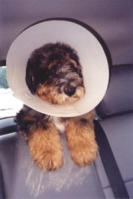
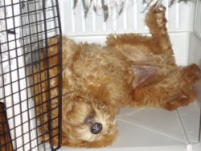

Some pups come with their ‘homes’, others make themselves to home







The information contained on this site is in no way intended to
replace that of proper veterinary advice, diagnosis or treatment.
It is meant to provide resource, so that we can better understand
canine health related issues.



